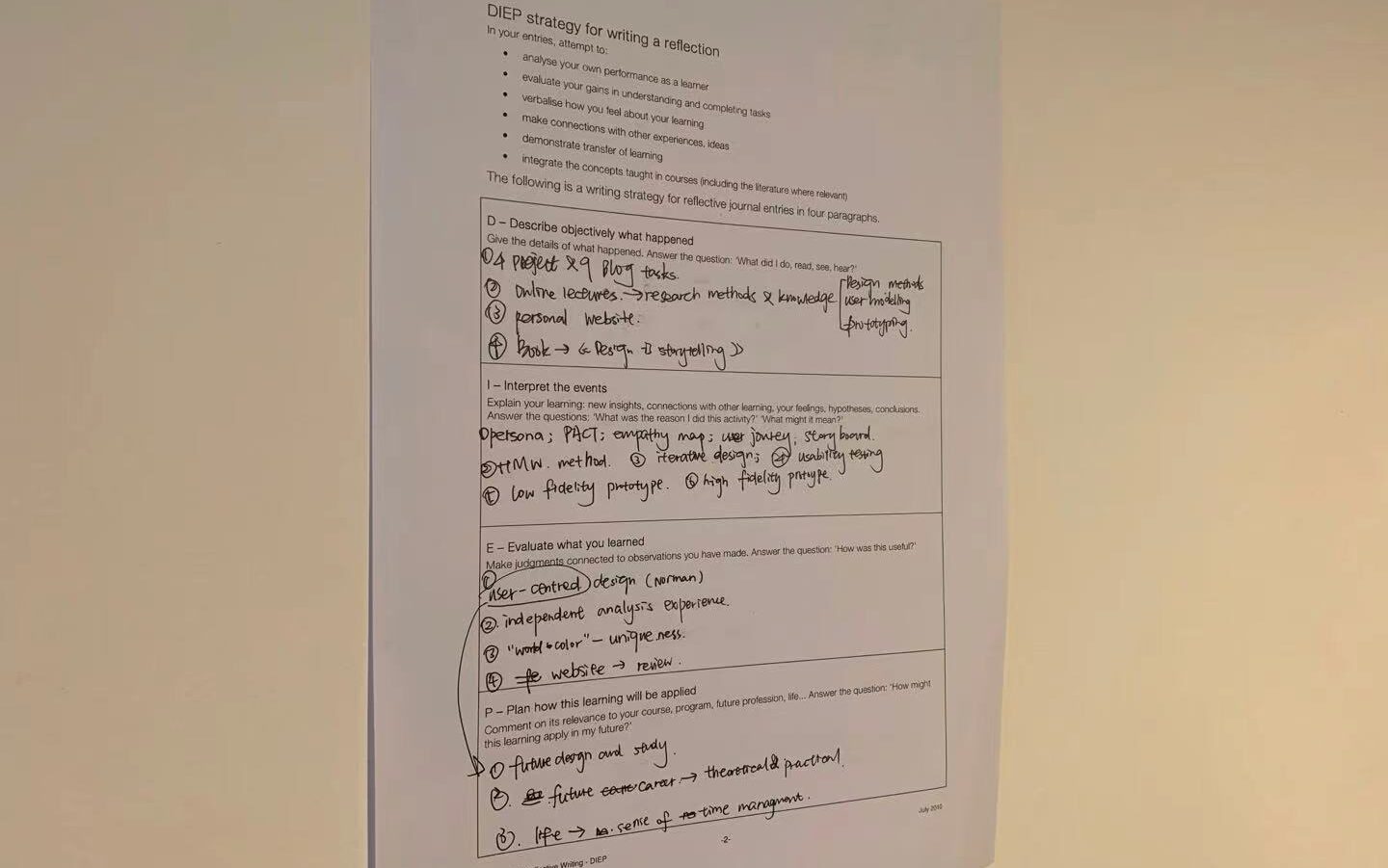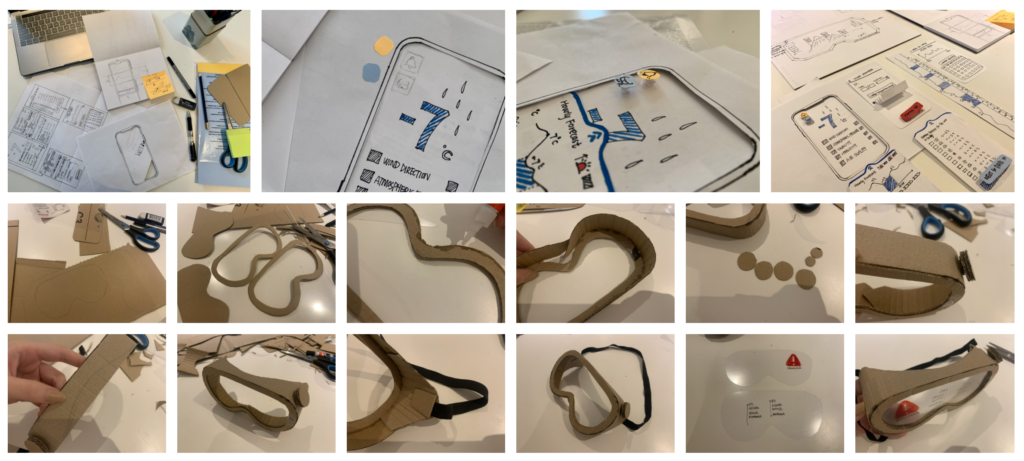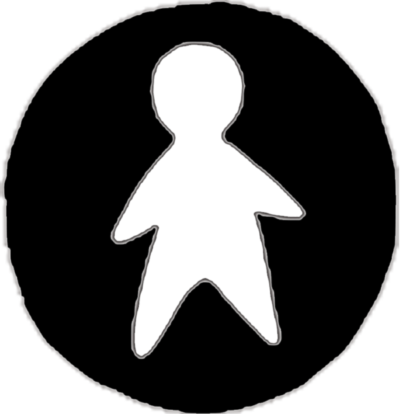Introduction
In this paper, I used the DIEP worksheet of RMIT University (RMIT University, 2021) to reflect on the course of New Media &Design. I will review my past work and performance from four aspects: describe, interpret, evaluate and plan.

Describe
In the New Media &Design module, I have completed four projects and nine blog tasks. Every Monday, we have about two hours of online lectures. I learned many knowledge points and research methods of interaction design from the class, including design methods, user modelling techniques, low/high fidelity prototyping, iteration of the design, etc. At the beginning of each project, we are given a brief that describes the objectives and outcomes of the project. Each project is tightly integrated and logically corresponds to the appropriate learning stage. These projects are discussed in weekly group meetings and get feedback, and I modify them based on this feedback.
In addition, the weekly blog task requires us to read some articles of designers and videos about design insights and record our insights with text or Sketch notes. Finally, I will put all the above into personal website. In addition, Design is Storytelling (Lupton, 2017) is the first book on user design that I read after the beginning of the course. The book describes some methods needed for user design with fascinating illustrations and easy-to-understand examples. The knowledge mentioned in this book also runs through my study of the whole module.
Interpret
Unlike the graphic design and graphic design I learned in my undergraduate study, the interaction design we learned in this course is a new discipline that I have never contacted before. At first, it was hard for me to get out of the graphic design mindset. In my opinion, interaction design pays more attention to user experience than graphic design, and it is more like it exists to solve problems. However, as the teaching progressed, I gained new insights into interaction design, especially after learning how to analyse users.
Build a user model, can let the product requirements concrete. Then, I put these techniques to practical use in my second project, where I built personas, empathy map, user journey and storyboard through user interviews and questionnaires. Persona allows me to eliminate my assumptions and find out what the user wants. Unlike persona, the empathy map enables me to establish empathy with the user, quickly let me feel what the user may see, think and hear, and visualise my understanding of the user. Moreover, with the in-depth study of the user, I can update the empathy map at any time to ensure its accuracy. The user journey map is also a good tool for me to understand users. It allows me to sort out user behaviours and get corresponding emotional feedback to optimise user behaviours. Finally, the storyboard is one of my weaknesses. I need to place the user in a specific scene by drawing, but because I did not draw details, I could not empathize with the user, which I did not think of.

I also learned the HOW MIGHT WE method. After the design challenges were identified in the fourth project, this method was significant for me to propose solutions to design challenges. I presented myself with a list of questions to explore the connections between different answers and open my mind and creativity.
I read the concept of Affordances proposed by James Jerome Gibson (Kaptelinin, 2021) in my blog task. When this concept is integrated into the interactive design, I realise that a good design should be easy to use without instructions. To achieve this goal, I began to focus on iterative design (Nielsen, 1993) and user usability testing (Dumas and Redish, 1999). Like sharpening a pencil, the design has to be sharpened over and over again. Nevertheless, even if the process is a little slow, in the end, I will come up with a good solution. For example, in the third project, through usability testing, I got valuable feedback from users that the smart goggles might not be able to hear their voice commands under harsh conditions. Therefore, I changed the starting mode of the intelligent goggles from speech control to a physical switch, which solved the voice control problem in the blizzard and noisy environment. This test enabled my project to complete the iteration and improved the product’s experience and ease of use.

Not only that but the iteration of the design was also reflected in the weekly group meeting. Unfortunately, due to COVID-19, I could not talk with my tutor and classmates face to face, but we still had an online discussion via video conference. Therefore, I will think about my project again according to the feedback and suggestions from my tutor and classmates and use the critical thinking I have mastered in the Professional and Academic Skills (Practice) class to think about the reasons and significance of my doing so. For example, have I solved the design challenge? Is my project unique? In addition, making the low fidelity prototype was the most exciting part of the whole process. The low fidelity paper prototype was not only suitable for my early functional testing and fixing significant problems but also very easy to display, whether 2D or 3D paper prototype. In addition, I feel relaxed and interested in the process of making.

Finally, the high fidelity prototype of Project four is the part that I think is more difficult. Unlike low fidelity prototype and wireframes, a high fidelity prototype not only reflects the flow, logic, and layout of the product it also represents the final visual and operational state of the product. Although it took me much time to make a high-fidelity prototype, I think it was worth it to reduce the cost of communication with users and show the final effect of the product more directly. However, in terms of the effect of the prototype, my visual design is not so excellent, probably because I spent too much energy in the preliminary user research and the process of looking for design challenges, so I did not set aside enough time for this part. Therefore, in future design, I need to reasonably plan the time of each part to ensure that each part has sufficient time to complete. However, making high-fidelity prototypes still sharpened my prototyping software and enriched my skill
Evaluate
After three and a half months of study, I have successfully mastered the user-centred design (Norman, 2013) thinking mode, which enables me to look for their needs from users’ perspective. Before this, I had never set foot in this field. However, learning to design from the users’ perspective enables me to solve better practical problems with design, which I have been pursuing.
Not only that, I deeply understand the importance of theoretical support in interaction design. Taking user analysis as an example, the user modelling techniques I used in the four projects were PACT analysis, persona, empathy map, user journey, and storyboard. Indeed, these user-modelling techniques enable me to analyse users logically. Therefore, I have independent analysis experience in analysing a user group and finding their needs by building a user model.
The most important thing is that I need to work hard on the uniqueness of the product. Taking the fourth project, “World Color,” as an example, I need to find out the difference between it and other social media. My core competitiveness seems not so obvious, so making users choose my design instead of others is what I need to work hard on.
In addition, the purpose of building a website for myself is not just to submit my homework but also to integrate my work and visually present it. In building a personal website, I also reviewed and adjusted the work I have done. In order to ensure the convenience of users’ browsing, I changed the details of the project and the interactivity of the website. For me who want to be a professional designer in the future, I can continue to publish my works by setting up a personal website, which is also very helpful for me to form my unique design style.
Plan
The learning during this period is a precious asset for me. I will continue to bring the user-centred concept learned in this module into my future design and study. What is more important is that my learning achievements have accumulated the theoretical foundation and complete practical experience of user design that a design professional should have for my future career. In similar situations in the future, I will make proper use of these experiences and further develop them in practice. What is more, I have learned to plan my time reasonably. I will bring this good habit into my life. Proper planning of study time and entertainment time and a good sense of time management can help me do everything in an organised way.
Reference
Dumas, J. and Redish, J. (1999) A practical guide to usability testing. Exeter, England: Intellect Books.
Kaptelinin, V. (2021) Affordances. [online] The Interaction Design Foundation. Available at: https://www.interaction-design.org/literature/book/the-encyclopedia-of-human-computer-interaction-2nd-ed/affordances [Accessed 16 May 2021].
Lupton, E. (2017) Design is storytelling. New York: Cooper Hewitt, Smithsonian Design Museum.
Norman, D. (2013) The design of everyday things. New York, NY: Basic Books.
Nielsen, J. (1993) Iterative user-interface design. Computer, 26(11), pp.32-41.
Rmit.edu.au. (2021) RMIT University. [online] Available at: https://www.rmit.edu.au/ [Accessed 16 May 2021].
